The Palazzo Larderel, once Tebalducci and Giacomini is a Renaissance-style palace, located on Via de' Tornabuoni number 19, corner via de' Giacomini 1, in the city of Florence, region of Tuscany, Italy.

The Palazzo Larderel, once Tebalducci and Giacomini is a Renaissance-style palace, located on Via de' Tornabuoni number 19, corner via de' Giacomini 1, in the city of Florence, region of Tuscany, Italy.

A house at the site was originally built by the descendants of the 13th-century citizen Gherardo Tebalducci, who took the surname Giacomini for their family. They had bought additional lots in 1480 from the Antinori family. The design of the three-story palace was completed in 1580 by Giovanni Antonio Dosio.
The Giacomini had been supporters of the anti-Medici Republic of Florence that lasted from 1527-1529. However, despite the political misfortunes, the family prospered. After last Giacomini owner of the palace died in 1764, the palace passed through diverse owners. In 1839, the palace was bought by Count Francois de Larderel, a French merchant who profited from borax mines at Volterra. [1] Three coats of arms are featured on the corner, Giacomini, Boni, and Larderel. The latter has two ermines and fuming mounds referencing the family trade. [2]
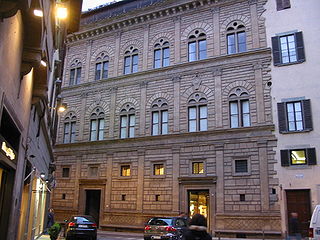
Palazzo Rucellai is a palatial fifteenth-century townhouse on the Via della Vigna Nuova in Florence, Italy. The Rucellai Palace is believed by most scholars to have been designed for Giovanni di Paolo Rucellai by Leon Battista Alberti between 1446 and 1451 and executed, at least in part, by Bernardo Rossellino. Its splendid facade was one of the first to proclaim the new ideas of Renaissance architecture based on the use of pilasters and entablatures in proportional relationship to each other. The Rucellai Palace demonstrates the impact of the antique revival but does so in a manner which is full of Renaissance originality.

Palazzo Strozzi is a palace in Florence, Italy.

Palazzo Mozzi or Palazzo de' Mozzi is an early Renaissance palace, located at the end of the Piazza de' Mozzi that emerges from Ponte alle Grazie and leads straight to the palace where via San Niccolò becomes via de' Bardi in the Quartiere of Santo Spirito in the Oltrarno section of Florence, region of Tuscany, Italy. The 13th-century palace housed the gallery of the highly successful antiquarian Stefano Bardini, of which the remnants were left to the commune, where they assembled the Museo Bardini or Mozzi Bardini, displaying Florentine art and artifacts up to the early Renaissance. The gardens elaborated against the hillside behind the palace were added mainly by Bardini.
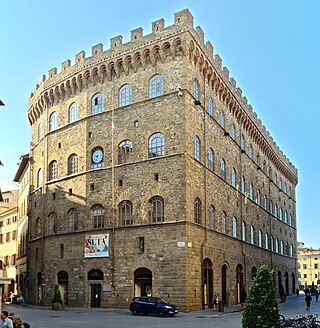
Palazzo Spini Ferroni is a large Gothic palace located along Via de' Tornabuoni at the corner of Piazza Santa Trinita, in central Florence, Tuscany, Italy. It stands across from the church of Santa Trinita.
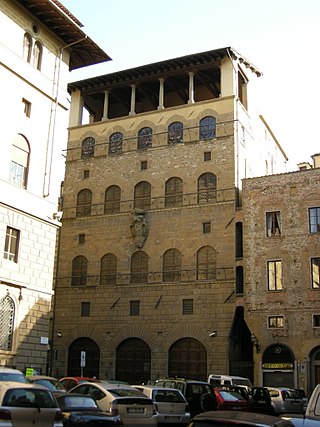
Palazzo Davanzati is a palace in Florence, Italy. It houses the Museum of the Old Florentine House.
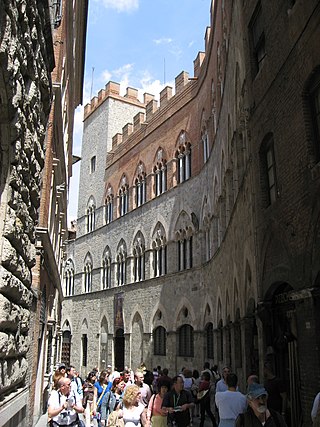
The Palazzo Chigi-Saracini is a Gothic urban palace on the Via di Città in the Terzo di Città in central Siena, Tuscany, Italy. It is the seat of the Accademia Musicale Chigiana.
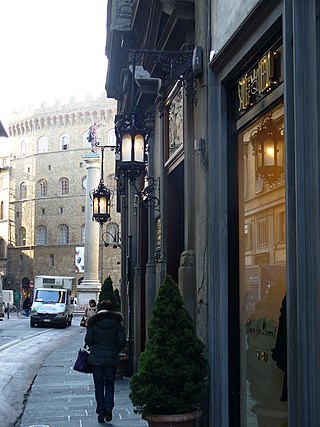
Via de' Tornabuoni, or Via Tornabuoni, is a street at the center of Florence, Italy, that goes from Antinori square to Ponte Santa Trinita, across Santa Trinita square, distinguished by the presence of fashion boutiques.
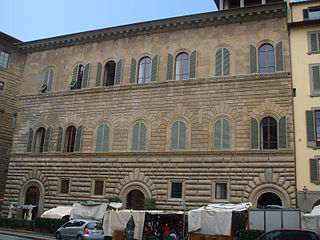
Palazzo Gondi is a palace in Florence, Italy, located a block from Piazza della Signoria. It was built in 1490 under design by Giuliano da Sangallo, who was inspired by other major works of stately buildings in the city, such as Palazzo Medici and Palazzo Strozzi. Among the elements borrowed from these earlier works are the cube-shape set around a central courtyard, the ashlar sloping on each of three floors, and the arched windows.
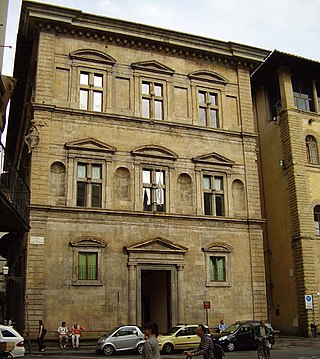
The Palazzo Bartolini Salimbeni is a High Renaissance-style palace located on Via de' Tornabuoni on Piazza Trinita in central Florence, Italy.

Palazzo Antinori is a Renaissance palace located at the north end of Via de' Tornabuoni, where it makes an odd corner with Via dei Pecori, Via del Trebbio, and converts into Via dei Rondinelli, in Florence, Italy.

The Palazzo Piccolomini, also known as the Palazzo Todeschini Piccolomini is a Renaissance-style palace in the city of Siena, region of Tuscany, Italy. It is located on the Banchi di Sotto, at the corner with Via Rinaldini; uphill and west of the church of San Martino, the Loggia del Papa, and the Palazzo delle Papesse, which also built by a Piccolomini family member.
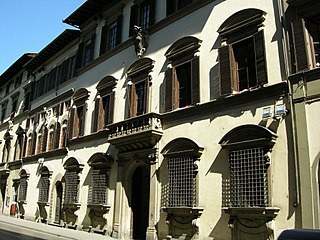
The Palazzo Capponi Covoni is a Baroque architecture palace in Florence, region of Tuscany, Italy. There are apparently three other palaces once associated with the Capponi family:

The Palazzo Minerbetti is an urban palace building located on Via de' Tornabuoni #3 at the corner with Via del Parione, which edges into the Piazza Santa Trinita, Florence, in central Florence, Italy.

The Palazzo Pazzi, also known as the Palazzo della Congiura or Palazzo Pazzi-Quaratesi is a Renaissance-style palace. It is located on Via del Proconsolo 10 at the corner with Borgo Albizzi in Florence, region of Tuscany, Italy. The palace is between the Palazzo Nonfinito and the Palazzo Pazzi-Ammannati to the north.

The Palazzo Panciatichi is a Renaissance palace located on Via Camillo Cavour 2 in the quartiere of San Giovanni, Florence, region of Tuscany, Italy. A different Palazzo Panciatichi-Ximenes or Ximenes-da Sangallo is located at Borgo Pinti 68, corner of via Giusti, in Florence.

The Palazzo Nasi, also known as the Palazzo Torrigiani or Palazzo Scarlatti, is a palace located at Piazza de' Mozzi 4, down the street where the Ponte alle Grazie enters the Oltrarno, in Florence, Tuscany, Italy. Another Palazzo Torrigiani Del Nero, with a Mannerist or late-Renaissance-style facade stands closer to the river. Both palaces also once belonged to the Nasi. The palace is a few steps from the Palazzo Mozzi.
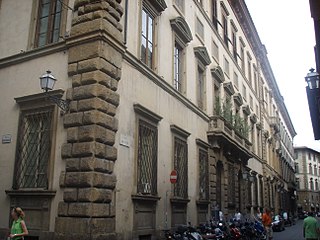
The Palazzo Pucci is a palace located at Via dei Pucci 4 in central Florence in the region of Tuscany, Italy. The façade of the palace spans from Via dei Servi to Via Ricasoli.
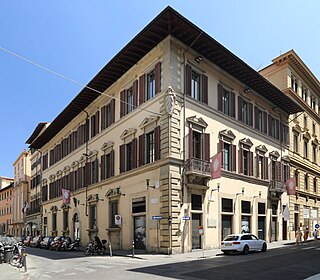
The Palazzo Vecchietti is a Renaissance architecture palace located on Via degli Strozzi number 4, near Piazza della Repubblica in the quartieri of Santa Maria Novella, city of Florence, region of Tuscany, Italy.
The Palazzo Tempi, also known as Palazzo Vettori or Bargagli Petrucci, is a palace located along the Arno river at the narrow Piazza Santa Maria Soprarno 1, corner with Via de' Bardi and Costa dei Magnoli in the Oltrarno section of Florence, Tuscany, Italy. The palace is across the river from the Galleria of the Uffizi, and a block east of the Ponte Vecchio. The Via de' Bardi originates in an arch under the building.

The Palazzo Canigiani, initially built as Palazzo Bardi-Larioni, and later also known as Canigiani-Guigni is a Neoclassic-style palace located in Via de' Bardi 28 in the quartiere of Santo Spirito in central Florence, region of Tuscany, Italy.